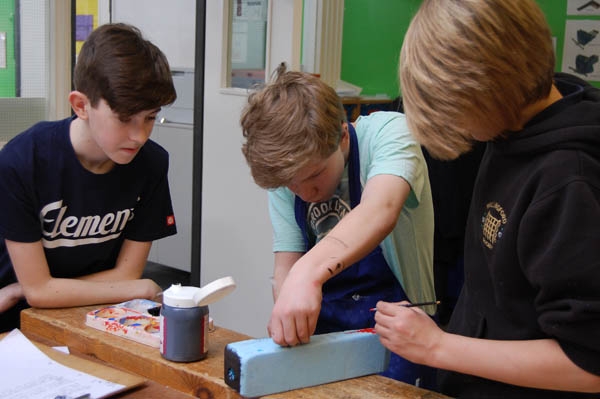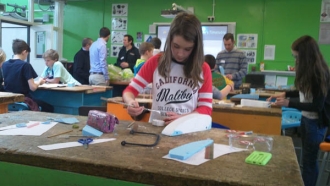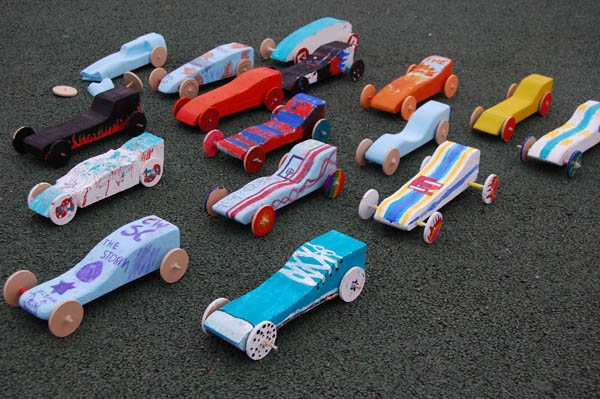
Will Pickford, BP (Castrol) – BLOODHOUND Ambassador, reports on a pilot event at a BP Link (secondary) school.
As excitement and tension mounted in the playground, the entire year group began the countdown: "5…4…3…2…1!"
 And with the kind of “Whoosh!” normally associated with a firework, the first model rocket car shot off from the start line, accelerating fast along the 50 metre race track and through the speed trap. Huge applause and shouts of support followed as the recorded time of 45.92mph was announced. At that point we knew for sure we were successfully delivering a BLOODHOUND event and enthusing a younger generation of girls and boys in STEM activity.
And with the kind of “Whoosh!” normally associated with a firework, the first model rocket car shot off from the start line, accelerating fast along the 50 metre race track and through the speed trap. Huge applause and shouts of support followed as the recorded time of 45.92mph was announced. At that point we knew for sure we were successfully delivering a BLOODHOUND event and enthusing a younger generation of girls and boys in STEM activity.
The launching of these model rocket cars was the final part of what had been a full day of BLOODHOUND activity at Icknield Community College in Oxfordshire for Year 7. It was also the culmination of a significant effort to develop a bespoke event for an off-timetable ‘creative learning day’.
Our event was divided into phases to align with the school timetable periods, comprising presentations in class, design and build phases in workshops and a final demonstration phase in the playground – with a hard stop in time for awards and buses home!
Setting the scene
 The day started with presentations to introduce the class to land speed records and the BLOODHOUND project with its ambition to reach 1,000mph. Then a well prepared presentation provided some technical insight into what’s required to achieve 1,000mph and the engineering challenges faced, with emphasis on power versus drag.
The day started with presentations to introduce the class to land speed records and the BLOODHOUND project with its ambition to reach 1,000mph. Then a well prepared presentation provided some technical insight into what’s required to achieve 1,000mph and the engineering challenges faced, with emphasis on power versus drag.
Throughout the day, it was genuinely surprising how the students grasped the concepts and generated ideas and questions – and it made us realise how well versed an ambassador needs to be with the technical side of the BLOODHOUND project.
Design and build
We moved on to the design and build phases in the school workshops where we enjoyed seeing the creativity of young minds that have no pre-conceptions of what can or can’t be done. This produced some really innovative thinking as they got stuck into the task.
 Our teams were each provided with a model rocket car build kit which included a Styrofoam rectangular block that required some aerodynamic improvements within the technical regulations given. Team ‘Fly High’ produced an outstanding design by shortening the nominal axle width to recede the wheel sets into the bodywork.
Our teams were each provided with a model rocket car build kit which included a Styrofoam rectangular block that required some aerodynamic improvements within the technical regulations given. Team ‘Fly High’ produced an outstanding design by shortening the nominal axle width to recede the wheel sets into the bodywork.
The teams optimised their designs further in the build phase, pushing the balance of performance versus reliability as more material was sculpted away using a variety of workshop tools and equipment. Team ‘Sparticus 9000’ even employed a laser cutter, programming it to etch their team name along the side of their car. Meanwhile ‘Team Converse’ took inspiration from their shoes and made their car appear to be a flying trainer.
Quietly on the side, one of our crew – a skilled technician – made a very good replica of the BLOODHOUND car which was appropriately named ‘Mini-hound’.
Firing up the cars
 The main event of the day was the demonstration phase, where we fired the model rocket cars along the 50 metre track. We had prepared and tested the tensioned guide-wire and speed trap in advance and had agreed responsibilities for each of our crew. (The BLOODHOUND team have prepared good guidance notes on how to do all of this, but it’s imperative that any crew actually practice this.) We had just a 45 minute window to complete this, so it needed to be an efficient and professional operation to get through 16 cars including Mini-hound.
The main event of the day was the demonstration phase, where we fired the model rocket cars along the 50 metre track. We had prepared and tested the tensioned guide-wire and speed trap in advance and had agreed responsibilities for each of our crew. (The BLOODHOUND team have prepared good guidance notes on how to do all of this, but it’s imperative that any crew actually practice this.) We had just a 45 minute window to complete this, so it needed to be an efficient and professional operation to get through 16 cars including Mini-hound.
Cars were prepared with ‘B’ size motors appropriate to the 50 metre track length, which meant they would be at maximum speed at around 25 metres and be slowing down by the end stop. The gathering of teachers and students created an exciting atmosphere and we only wound them up more with some running commentary and involvement in the countdown to launch each time. It was wonderful that the neighbouring nursery school also came out to watch with the toddlers – it seems there’s no minimum age to be inspired by BLOODHOUND!
As the cars were demonstrated there was some real competition amongst the teams as the maximum speed was announced for each run. The occasional wheel flew off along the track but it didn’t seem to affect the enthusiasm in any way.
For the grand finale Mini-hound was loaded with a larger ‘C’ size motor. This launch proved spectacular as the more powerful motor sent the car off down the track, but there was then a gasp from the crowd as the car continued to accelerate all the way up to the 50 metre line and slammed in to the end stop, smashing the car – somewhat destructive testing, perhaps, but a real crowd pleaser.
Recognising achievement
 Awards were given in three categories: best design awarded to team Fly High for their innovative inset wheel configuration; best artwork awarded to Team Converse for the flying trainer, and fastest car awarded to team The Storm for hitting the impressive speed of 48.96mph. Interestingly, this team had focused entirely on the performance side, with a highly sculpted design that they continued to optimise throughout the time most teams allocated to perfecting their artwork.
Awards were given in three categories: best design awarded to team Fly High for their innovative inset wheel configuration; best artwork awarded to Team Converse for the flying trainer, and fastest car awarded to team The Storm for hitting the impressive speed of 48.96mph. Interestingly, this team had focused entirely on the performance side, with a highly sculpted design that they continued to optimise throughout the time most teams allocated to perfecting their artwork.
 Everyone wins!
Everyone wins!
As a new BLOODHOUND Ambassador I was somewhat apprehensive about committing to deliver such an event, but the end result was highly rewarding for the students – and for the crew. I like to think we departed leaving a group of students well informed about the BLOODHOUND project, and excited about selecting STEM subjects for their GCSE options and careers.
If anyone is wondering where to start in running their own model rocket car event, then look no further than the BLOODHOUND educational team and the Ambassador network. I was helped by both and it made what seemed like a daunting task relatively straight-forward – with support provided for the pre-work and the delivery of the event on the day. I encourage you all to get involved.


